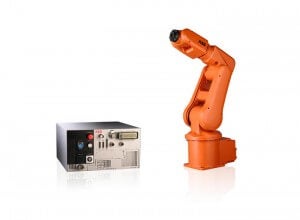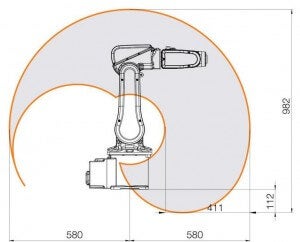History of industrial robotics
George Devol applied for the first robotics patents in 1954 (granted in 1961). The first company to produce a robot was Unimation, founded by Devol and Joseph F. Engelberger in 1956, and was based on Devol's original patents. Unimation robots were also called programmable transfer machines since their main use at first was to transfer objects from one point to another, less than a dozen feet or so apart. They used hydraulic actuators and were programmed in joint coordinates, i.e. the angles of the various joints were stored during a teaching phase and replayed in operation. They were accurate to within 1/10,000 of an inch (note: although accuracy is not an appropriate measure for robots, usually evaluated in terms of repeatability - see later). Unimation later licensed their technology to Kawasaki Heavy Industries and GKN, manufacturing Unimates in Japan and England respectively. For some time Unimation's only competitor was Cincinnati Milacron Inc. of Ohio. This changed radically in the late 1970s when several big Japanese conglomerates began producing similar industrial robots.
In 1969 Victor Scheinman at Stanford University invented the Stanford arm, an all-electric, 6-axis articulated robot designed to permit an arm solution. This allowed it accurately to follow arbitrary paths in space and widened the potential use of the robot to more sophisticated applications such as assembly and welding. Scheinman then designed a second arm for the MIT AI Lab, called the "MIT arm." Scheinman, after receiving a fellowship from Unimation to develop his designs, sold those designs to Unimation who further developed them with support from General Motors and later marketed it as the Programmable Universal Machine for Assembly (PUMA).
Industrial robotics took off quite quickly in Europe, with both ABB Robotics and KUKA Robotics bringing robots to the market in 1973. ABB Robotics (formerly ASEA) introduced IRB 6, among the world's first commercially available all electric micro-processor controlled robot. The first two IRB 6 robots were sold to Magnusson in Sweden for grinding and polishing pipe bends and were installed in production in January 1974. Also in 1973 KUKA Robotics built its first robot, known as FAMULUS, also one of the first articulated robots to have six electro mechanically driven axes.
Interest in robotics increased in the late 1970s and many US companies entered the field, including large firms like General Electric, and General Motors (which formed joint venture FANUC Robotics with FANUC LTD of Japan). U.S. startup companies included Automatix and Adept Technology, Inc. At the height of the robot boom in 1984, Unimation was acquired by Westinghouse Electric Corporation for 107 million U.S. dollars. Westinghouse sold Unimation to Stäubli Faverges SCA of France in 1988, which is still making articulated robots for general industrial andcleanroom applications and even bought the robotic division of Bosch in late 2004.
Only a few non-Japanese companies ultimately managed to survive in this market, the major ones being: Adept Technology, Stäubli-Unimation, the Swedish-Swiss company ABB Asea Brown Boveri, the German company KUKA Robotics and the Italian company Comau.
Modern industrial robots are true marvels
of engineering. A robot the size of a person can easily carry
a load over one hundred pounds and move it very quickly with a
repeatability of +/-0.006 inches. Furthermore these robots can
do that 24 hours a day for years on end with no failures
whatsoever. Though they are reprogrammable, in many
applications (particularly those in the auto industry) they
are programmed once and then repeat that exact same task for
years.
A six-axis robot like the yellow one
below costs about $60,000. What I find interesting is that
deploying the robot costs another $200,000. Thus, the cost of
the robot itself is just a fraction of the cost of the total
system. The tools the robot uses combined with the cost of
programming the robot form the major percentage of the cost.
That's why robots in the auto industry are rarely
reprogrammed. If they are going to go to the expense of
deploying a robot for another task, then they may as well use
a new robot.

Seen here next to its controller, the ABB IRB 120 is the world's smallest industrial robot.
The world of industrial robots has welcomed the next master manipulator, the IRB20. From ABB (NYSE: ABB), the people who brought you the Flexpicker, IRB20 is not only deft, it’s also small. Weighing just 25kg, it still has a reach of more than half a meter and will likely function as an assembly line sorter and assembler. While the IRB20 sounds good on paper, it looks really cool in video. Check out the clip after the break, and I apologize, again, for the robotics industry’s obsession with pairing robot videos with bad techno music.
As robots move firmly into every aspect of manufacturing human concerns are being replaced by engineering restrictions. Look at a human worker and you have to consider experience, salary, and expectations. Look at a robotic worker and you have to consider space, weight, and versatility. In these realms the IRB20 really stands out. It has a small footprint, weighs little, and has a huge range of motion and applications. All that and it looks good dancing (check the video). It’s the robotic equivalent of a recent college graduate eager to please around the office.
Watching the IRB20 glide around glibly on its six axes, I’m struck by the notion that this bot could probably outperform me in about any manual task I’d care to try. The robot takes up very little room (just 180mm X 180mm), can reach 112mm below its base, weighs around 25 kg, and is easily mounted in any position. Human workers have much larger work areas ( > 500mm x 500mm), can sometimes touch their toes, weigh around 70+ kg, and mounting them…ok, let’s not go there. The fact is, that many assembly line workers will look at IRB20 and see their eventual replacement.
Which may or may not be a bad thing for assembly line workers. As robotics take over a large portion of manual manufacturing efficiency will increase, as will profits. More profits at a company generally leads to more jobs. The kinds of manufacturing jobs humans are used for may be changing, but the number of jobs at manufacturing companies may not decline. Growth in service, maintenance, and administration will likely accompany the continuing roboticization of factories.

How can you beat that range of motion?
Of course, no matter their effect on employment, robots are going to continue increasing their dominance in industrial work. ABB has already installed 160,000 robots worldwide, and the IRB20 is poised to be a best seller. Whether you look at the robotic workforce and see increased human leisure time, or can only lament the decline of the human worker, the end results are the same. The future of our economy is going to be a blend of human and robot labor, and the human labor is going to be less manual than it was before. So, for better or worse, let’s welcome the IRB20 to the job. It has some big shoes to fill.
 They were educators frustrated by the lack of flexible, easily accessible tools for teaching robotics. So they created the Multiplo Robot Building Kit, an open source robot building system meant to help people “learn by doing.” And, based on the success of theirKickstarter campaign, it looks as though the hackers are ready. They reached their original goal of $15,000 in just two days and, by the campaign’s end, raised over $132,000. They were educators frustrated by the lack of flexible, easily accessible tools for teaching robotics. So they created the Multiplo Robot Building Kit, an open source robot building system meant to help people “learn by doing.” And, based on the success of theirKickstarter campaign, it looks as though the hackers are ready. They reached their original goal of $15,000 in just two days and, by the campaign’s end, raised over $132,000.
The kit comes with everything you need to build your own robot. They say it takes only about 45 minutes to assemble a robot. No specialized knowledge or soldering required, as the pieces – servos, plates, arms, sensors, control unit – are made to fit easily together. The controller is called DuinoBot and is compatible with the Arduino microcomputer that handles motor outputs and connects to sensors. And people with the knowhow can use Arduino IDE to give their robots more advanced functions. The robots are controlled with a TV remote. It also comes with simple graphics-based software – also the product of asuccessful Kickstarter campaign – that beginners can use to program commands. A major priority in creating Multiplo was its simple, open source hardware. To “learn by doing,” builders are encouraged to reproduce the parts and eventually start coming up with their own designs. The Kickstarter campaign has ended and contributors start receiving their kits February 2013.
Initially the team that includes a teacher, two engineers and a robotics specialist wanted to prototype robots. They soon realized that the tools they were using could and should be shared with others. As mentioned in the video, “There are some other options out there. Big corporations with copyright protection ensures that learning robotics is only for the elite.” So yes, they’ve obviously been frustrated DIYers in search of simple, affordable, open source robotics. Lucky for us, they decided to make it themselves.
|
No comments:
Post a Comment